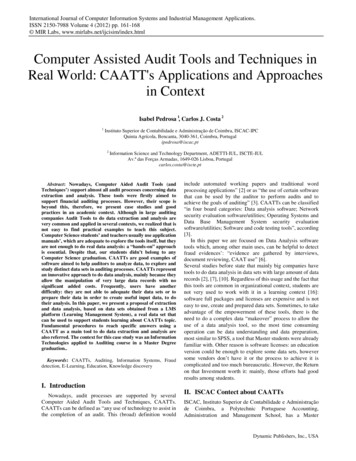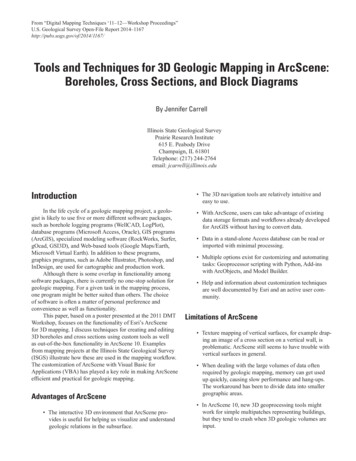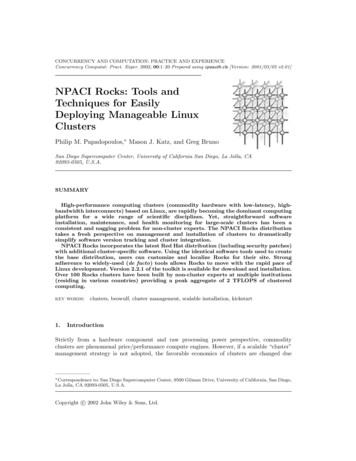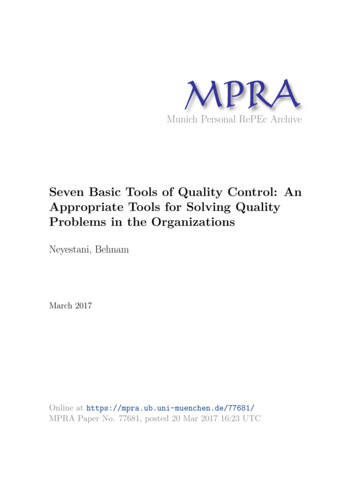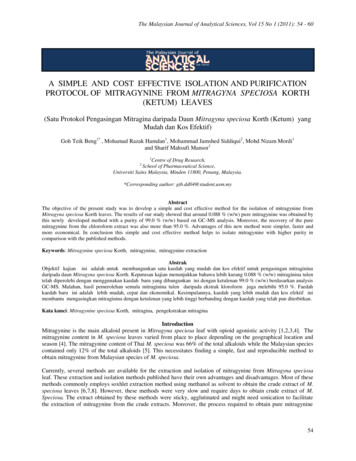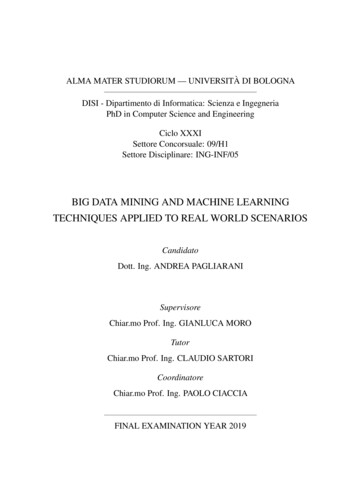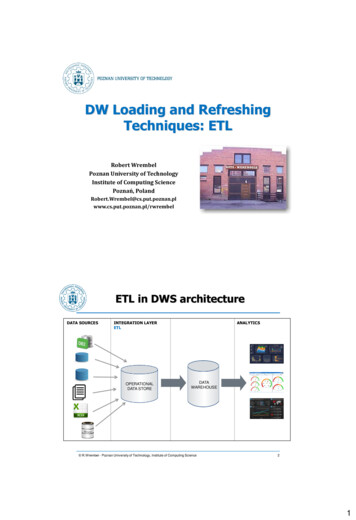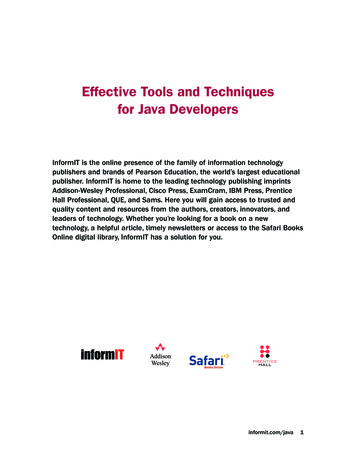
Transcription
Effective Tools and Techniquesfor Java DevelopersInformIT is the online presence of the family of information technologypublishers and brands of Pearson Education, the world’s largest educationalpublisher. InformIT is home to the leading technology publishing imprintsAddison-Wesley Professional, Cisco Press, ExamCram, IBM Press, PrenticeHall Professional, QUE, and Sams. Here you will gain access to trusted andquality content and resources from the authors, creators, innovators, andleaders of technology. Whether you’re looking for a book on a newtechnology, a helpful article, timely newsletters or access to the Safari BooksOnline digital library, InformIT has a solution for you.informit.com/java1
This paper includes a collection of excerpts from titles published by Pearson Educationincluding Addison-Wesley and Prentice Hall and pointers to resources for Java developersand programmers at all levels. The contents include: Creating and Destroying Objects by Joshua Bloch Clean Code by Robert C. Martin Behavior by Kent Beck Tag Libraries: The Basics by Marty Hall, Larry Brown, and Yaakov ChaikinRecommended ResourcesCopyright 2008 by Pearson Education, Inc. All rights reserved. No part of thispublication may be reproduced, stored in a retrieval system, or transmitted, in any form,or by any means, electronic, mechanical, photocopying, recording, or otherwise, withoutthe prior consent of the publisher.For information on obtaining permission for use of material from this work, please submita written request to:Pearson Education, Inc.Rights and Contracts Department75 Arlington Street, Suite 300Boston, MA 02116Fax: (617) 848-7047informit.com/java2
ContentsArticle 1: Effective Javaby Josh BlochArticle 2: Clean Codeby Robert C. MartinArticle 3: Implementation Patternsby Kent BeckArticle 4: Core Servletsby Marty Hall, Larry Brown, and Yaakov ChaikinRecommended Resourcesinformit.com/java3
Article 1—Effective JavaJoshua Bloch is the Chief Java Architect at Google. Previously he was a Distinguished Engineer at Sun Microsystems and a Senior Systems Designer atTransarc. He led the design and implementation of numerous Java platform features, including the JDK 5.0 language enhancements and the Java CollectionsFramework. He holds a Ph.D. in Computer Science from Carnegie-Mellon University and a B.S. in Computer Science from Columbia University.Java expert Josh Bloch discusses creating and destroying objects: when and howto create them, when and how to avoid creating them, how to ensure they aredestroyed in a timely manner, and how to manage any cleanup actions that mustprecede their destruction.Chapter 2Creating and Destroying ObjectsThis chapter concerns creating and destroying objects: when and how to create them, when andhow to avoid creating them, how to ensure they are destroyed in a timely manner, and how to manage any cleanup actions that must precede their destruction.Item 1:Consider static factory methods instead of constructorsThe normal way for a class to allow a client to obtain an instance of itself is to provide a publicconstructor. There is another technique that should be a part of every programmer’s toolkit. A classcan provide a public static factory method, which is simply a static method that returns an instanceof the class. Here’s a simple example from Boolean (the boxed primitive class for the primitivetype boolean). This method translates a boolean primitive value into a Boolean object reference:public static Boolean valueOf(boolean b) {return b ? Boolean.TRUE : Boolean.FALSE;}Note that a static factory method is not the same as the Factory Method pattern from DesignPatterns [Gamma95, p. 107]. The static factory method described in this item has no direct equivalent in Design Patterns.A class can provide its clients with static factory methods instead of, or in addition to, constructors. Providing a static factory method instead of a public constructor has both advantages anddisadvantages.informit.com/java4
One advantage of static factory methods is that, unlike constructors, they have names. Ifthe parameters to a constructor do not, in and of themselves, describe the object being returned, astatic factory with a well-chosen name is easier to use and the resulting client code easier to read.For example, the constructor BigInteger(int, int, Random), which returns a BigInteger thatis probably prime, would have been better expressed as a static factory method named BigInteger.probablePrime. (This method was eventually added in the 1.4 release.)A class can have only a single constructor with a given signature. Programmers have beenknown to get around this restriction by providing two constructors whose parameter lists differonly in the order of their parameter types. This is a really bad idea. The user of such an API willnever be able to remember which constructor is which and will end up calling the wrong one bymistake. People reading code that uses these constructors will not know what the code does without referring to the class documentation.Because they have names, static factory methods don’t share the restriction discussed in theprevious paragraph. In cases where a class seems to require multiple constructors with the samesignature, replace the constructors with static factory methods and carefully chosen names to highlight their differences.A second advantage of static factory methods is that, unlike constructors, they are notrequired to create a new object each time they’re invoked. This allows immutable classes (Item15) to use preconstructed instances, or to cache instances as they’re constructed, and dispense themrepeatedly to avoid creating unnecessary duplicate objects. The Boolean.valueOf(boolean)method illustrates this technique: it never creates an object. This technique is similar to the Flyweight pattern [Gamma95, p. 195]. It can greatly improve performance if equivalent objects arerequested often, especially if they are expensive to create.The ability of static factory methods to return the same object from repeated invocations allowsclasses to maintain strict control over what instances exist at any time. Classes that do this are saidto be instance-controlled. There are several reasons to write instance-controlled classes. Instancecontrol allows a class to guarantee that it is a singleton (Item 3) or noninstantiable (Item 4). Also,it allows an immutable class (Item 15) to make the guarantee that no two equal instances exist:a.equals(b) if and only if a b. If a class makes this guarantee, then its clients can use the operator instead of the equals(Object) method, which may result in improved performance.Enum types (Item 30) provide this guarantee.A third advantage of static factory methods is that, unlike constructors, they can returnan object of any subtype of their return type. This gives you great flexibility in choosing theclass of the returned object.One application of this flexibility is that an API can return objects without making their classespublic. Hiding implementation classes in this fashion leads to a very compact API. This techniquelends itself to interface-based frameworks (Item 18), where interfaces provide natural return typesfor static factory methods. Interfaces can’t have static methods, so by convention, static factorymethods for an interface named Type are put in a noninstantiable class (Item 4) named Types.For example, the Java Collections Framework has thirty-two convenience implementations ofits collection interfaces, providing unmodifiable collections, synchronized collections, and the like.Nearly all of these implementations are exported via static factory methods in one noninstantiableclass (java.util.Collections). The classes of the returned objects are all nonpublic.The Collections Framework API is much smaller than it would have been had it exportedthirty-two separate public classes, one for each convenience implementation. It is not just the bulkof the API that is reduced, but the conceptual weight. The user knows that the returned object hasinformit.com/java5
precisely the API specified by its interface, so there is no need to read additional class documentation for the implementation classes. Furthermore, using such a static factory method requires theclient to refer to the returned object by its interface rather than its implementation class, which isgenerally good practice (Item 52).Not only can the class of an object returned by a public static factory method be nonpublic, butthe class can vary from invocation to invocation depending on the values of the parameters to thestatic factory. Any class that is a subtype of the declared return type is permissible. The class of thereturned object can also vary from release to release for enhanced software maintainability and performance.The class java.util.EnumSet (Item 32), introduced in release 1.5, has no public constructors,only static factories. They return one of two implementations, depending on the size of the underlying enum type: if it has sixty-four or fewer elements, as most enum types do, the static factoriesreturn a RegularEnumSet instance, which is backed by a single long; if the enum type has sixtyfive or more elements, the factories return a JumboEnumSet instance, backed by a long array.The existence of these two implementation classes is invisible to clients. If RegularEnumSetceased to offer performance advantages for small enum types, it could be eliminated from a futurerelease with no ill effects. Similarly, a future release could add a third or fourth implementation ofEnumSet if it proved beneficial for performance. Clients neither know nor care about the class ofthe object they get back from the factory; they care only that it is some subclass of EnumSet.The class of the object returned by a static factory method need not even exist at the time theclass containing the method is written. Such flexible static factory methods form the basis of service provider frameworks, such as the Java Database Connectivity API (JDBC). A service providerframework is a system in which multiple service providers implement a service, and the systemmakes the implementations available to its clients, decoupling them from the implementations.There are three essential components of a service provider framework: a service interface,which providers implement; a provider registration API, which the system uses to register implementations, giving clients access to them; and a service access API, which clients use to obtain aninstance of the service. The service access API typically allows but does not require the client tospecify some criteria for choosing a provider. In the absence of such a specification, the API returnsan instance of a default implementation. The service access API is the “flexible static factory” thatforms the basis of the service provider framework.An optional fourth component of a service provider framework is a service provider interface,which providers implement to create instances of their service implementation. In the absence ofa service provider interface, implementations are registered by class name and instantiated reflectively (Item 53). In the case of JDBC, Connection plays the part of the service interface, DriverManager.registerDriver is the provider registration API, DriverManager.getConnection isthe service access API, and Driver is the service provider interface.There are numerous variants of the service provider framework pattern. For example, the service access API can return a richer service interface than the one required of the provider, using theAdapter pattern [Gamma95, p. 139]. Here is a simple implementation with a service provider interface and a default provider:// Service provider framework sketch// Service interfacepublic interface Service {. // Service-specific methods go here}informit.com/java6
// Service provider interfacepublic interface Provider {Service newService();}// Noninstantiable class for service registration and accesspublic class Services {private Services() { }// Prevents instantiation (Item 4)// Maps service names to servicesprivate static final Map String, Provider providers new ConcurrentHashMap String, Provider ();public static final String DEFAULT PROVIDER NAME “ def ”;// Provider registration APIpublic static void registerDefaultProvider(Provider p) {registerProvider(DEFAULT PROVIDER NAME, p);}public static void registerProvider(String name, Provider p){providers.put(name, p);}// Service access APIpublic static Service newInstance() {return newInstance(DEFAULT PROVIDER NAME);}public static Service newInstance(String name) {Provider p providers.get(name);if (p null)throw new IllegalArgumentException(“No provider registered with name: “ name);return p.newService();}}A fourth advantage of static factory methods is that they reduce the verbosity of creating parameterized type instances. Unfortunately, you must specify the type parameters when you invoke theconstructor of a parameterized class even if they’re obvious from context. This typically requiresyou to provide the type parameters twice in quick succession:Map String, List String m new HashMap String, List String ();This redundant specification quickly becomes painful as the length and complexity of the typeparameters increase. With static factories, however, the compiler can figure out the type parameters for you. This is known as type inference. For example, suppose that HashMap provided thisstatic factory:informit.com/java7
Material is excerpted fromEffective Java, Second Edition9780321356680 Joshua Bloch Pearson Educationinformit.com/title/9780321356680Continue reading about creating and destroying px?p 1216151Want to hear more from Josh Bloch on Effective Java? See more at Effective Java Part I:http://www.informit.com/podcasts/episode.aspx?e 4731a039-7853-46a1-aa98-765739864fc7Effective Java Part II:
Article 1—Effective Java Joshua Blochis the Chief Java Architect at Google. Previously he was a Distin-guished Engineer at Sun Microsystems and a Senior Systems

